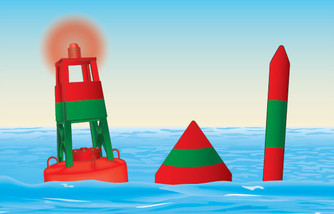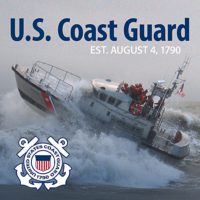
PREFERRED CHANNEL BUOYS
Ah the dreaded Preferred Channel Buoys, what are these beasts? This buoy sinks vessels in the blink of an eye and has been known to cause magnetic disturbances, no of course NOT! Read along and understand they’re not that complicated at all.
Preferred Channel Buoys are very helpful and easy to understand. A preferred channel buoy tells us which is the preferred channel of travel when the channel splits. So the preferred channel gets it label over time. Typically the larger, busier, more traveled channel becomes preferred and therefore considered to be safer. For an example its like comparing a highway to a back road. The preferred channel is where the majority of the traffic goes. This thought helps when approaching a preferred channel marker.
WHAT TO THE COLORS MEAN ON A PREFERRED CHANNEL BUOY
There are two ways to “read” this buoy. Firstly, remember what the top color means. If the top is green the preferred channel goes right. If the top is red the preferred channel goes left. Pretty easy. Secondly, recognize the majority color. Remember this buoy tells us where the majority of the traffic goes therefore to travel the preferred channel you treat this buoy with regards to its majority color: Two red stripes and one green, treat it like a red buoy to travel preferred. In the same vein, two green stripes and one red, treat it like a green buoy to travel preferred. Treat all three of the buoys pictured above like RED buoys if you want to travel the preferred channel. That is to say where the majority of the traffic goes.
A COUPLE OF SIDE NOTES
In addition to the above, here are a few more notables. Preferred Channel Buoys have no numbers. Interestingly enough, the numbers always flow through the preferred channel. Consequently the numbers always restart in the counterpart secondary channel. If an island causes the split in a channel one can always take either channel. On the other hand, there are no laws saying you must travel preferred unless posted by a local authoritative entity. In conclusion, lateral markers help us. In fact, very few operators know what all of them mean. Moreover, the United States Coast Guard Auxilliary has a great 14 page book “U.S. Aids to Navigation System” you can view and download for free.
IN CONCLUSION
Most importantly, there are no egos when passengers’ lives are in your hands. If it looks unsafe, it probably is. Be smart, be safe, and happy boating!
Please visit our Public Course Schedule to view all of the classes we have available for you. Zoom Classes are available now. There has never been an easier way to get your Boating Certificate
Here is a great article from U.S. Coast Guard Auxilliary Sierra Division 11 website regarding the preferred channel buoy: Regulatory Buoys (sierracgaux.org)






